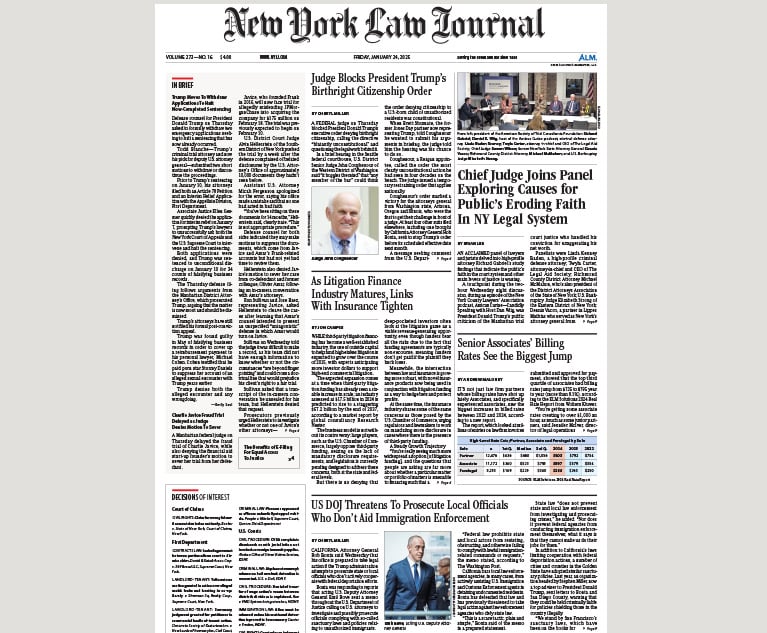Privacy and Protective Confidentiality Orders
In his column on Complex Litigation, Michael Hoenig encourages use of the protective order: a flexible device that harmonizes the demanding party's need for access with the producing party's competing right to privacy.
September 07, 2018 at 02:45 PM
11 minute read
 Michael Hoenig
Michael Hoenig
A decision issued by the Ninth Circuit in August (Center for Auto Safety v. Chrysler Group, 2018 U.S. App. LEXIS 23848 (9th Cir., Aug. 23, 2018) (unpublished)) reminded me how crucial it is for courts, when appropriate, to protect privacy interests of individuals, business firms and companies literally forced to produce confidential information during discovery. In this digital era particularly, when voluminous e-discovery obligations are the norm, privacy interests easily can be eroded.
In the Chrysler case, purchasers of certain vehicles filed a class action alleging defects in the vehicles' power systems. They claimed the vehicles did not promptly and reliably start, would stall at high speed, had fuel pumps that did not turn off, and manifested other problems. The district court issued a protective order permitting the parties to designate certain documents as “Confidential” in anticipation of a hearing on a motion for preliminary injunction. Only parties to the suit had access to the documents.
Along comes the Center for Auto Safety (CFAS) which moves to intervene and to unseal certain records. Chrysler opposed the motions, arguing “good cause” existed for maintaining the documents under seal. The district court denied CFAS' motions. The interest group appealed. The Ninth Circuit remanded the case instructing that Chrysler demonstrate compelling reasons to keep the documents under seal. The district court then performed a “meticulous in camera examination” of the exhibits, weighed relevant competing interests and determined that compelling interests justified Chrysler maintaining a category of redacted documents under seal. (Chrysler, LEXIS at *4-*5).
The Ninth Circuit affirmed. It rejected CFAS' claim that the public interest outweighed Chrysler's interest in maintaining them under seal. The appellate court also rejected CFAS' so-called “First Amendment” right to access Chrysler's records since that claim was not preserved for appellate review. Further, there was no independent jurisdictional basis for intervention “solely for the purpose of ensuring public access to court records.”
The Chrysler case, dealing with a protective order “sealing” discovery materials filed in court, raises broader policy questions regarding the increased need for protective confidentiality orders to be issued to preserve litigants' privacy interests. Some litigants think that for the relatively nominal cost of a case commencement filing fee they can simply conduct expansive discovery under extremely generous disclosure rules and then freely disseminate the most private, confidential, personal, embarrassing or commercially sensitive information they may acquire during discovery.
Further, certain nonlitigants, such as news or entertainment media, public interest groups or self-styled advocates for various causes urge that, once a lawsuit has been filed, they have some unbridled, hallowed right of “public access” to any and all pretrial discovery materials, however private the disclosed information might be. Indeed, lawsuits are filed precisely to obtain private information and expose it.
But if such so-called “public” interests in curiosity and suspicion trump one's rights to privacy, then why bother with the nominal formality of waiting for a case filing fee in order to pounce Just make everyone's life an open book so that the hunger for information normally to be found behind closed doors can easily be appeased. To but state the proposition shows the absurdity of extremist tendencies. Commencement of litigation is not a free-wheeling passport to examine and disseminate the innermost, intimate, confidential information of a litigant, however “relevant” one structures the quest to be.
Discovery Private
Although there indeed are strong rationales for public access to proceedings conducted in court, such as trials or open hearings, these reasons are inapposite when it comes to out-of-court, privately held discovery sessions.
We must not confuse public access to the courts with public access to essentially private information disgorged in response to generous discovery fashioned in order to help lawyers prepare for trial in court. The essence of the debate is well-reflected in the legal literature, including several incisive articles by Professor Richard L. Marcus, who served as a special reporter of the Judicial Conference's Advisory Committee on Civil Rules. As Professor Marcus makes clear, the threat to privacy has now been exacerbated exponentially by the digital revolution and electronic discovery. (See e.g., R.L. Marcus, “Secrecy in Litigation: A Modest Proposal: Recognizing (At Last) That the Federal Rules Do Not Declare That Discovery Is Presumptively Public,” 81 Chicago-Kent L. Rev. 331 (2006); A.R. Miller, “Confidentiality, Protective Orders, and Public Access to the Courts,” 105 Harv. L. Rev. 427 (1991); M. Hoenig, “Protective Confidentiality Orders,” New York Law Journal, March 5, 1990, p. 3; 13 J. Prods. Liab. 85 (1991)).
Even private corporate information regarding subjects over which some lawyers routinely may salivate—such as numbers of deaths and injuries during use of a product, property damage claims, consumer complaints, warranty claims, field reports and the like—is rightly considered confidential. This is well-illustrated in the rule on “Confidential Business Information” issued by the federal agency charged with regulating automobile safety standards, defect investigations and recall campaigns. It is recognized that such information is not necessarily indicative of defect trends, is of great value to a manufacturer's competitors, provides extremely valuable windows into competitive customer satisfaction and quality levels, and would enable one company to use the experience of another to select optimal designs, production processes, pricing strategies and the like.
The confidential and commercial value of consumer complaint data is well-recognized. Manufacturers vigorously compete and expend substantial amounts of research money on consumer satisfaction and quality in the market. The same is true about warranty claims data, a particularly sensitive subject from a competitive standpoint. The information also can be misused. For example, a manufacturer may be overly generous in remediating warranty claims to satisfy its customer base. Yet, in doing that, it may encourage, collect or log more claims than are justified. By allowing free dissemination, misuse or misinterpretation of confidential data could chill a manufacturer into abandoning an overly generous approach to warranty adjustments which may be better for the consumer in the long run.
One of the principal and flexible mechanisms given courts to prevent or minimize discovery abuse is the “protective order” device exemplified by Federal Civil Procedure Rule 26(c). This authorizes the court, in response to a motion showing “good cause” for relief, to issue any order that protects a party or person from “annoyance, embarrassment, oppression, or undue burden or expense.” The mere mention of these harmful consequences is the rule's acknowledgment of the great tension caused by the potential for intrusiveness.
Rule 26(c) catalogs a nonexclusive list of eight kinds of orders a court might fashion. One of the most meaningful where business or commercial entities are sued provides that a court may order “a trade secret or other confidential research, development or commercial information not be revealed or be revealed only in a specified way.” This provision is broadly worded. Although it is commonly referred to as the “trade secret” type of protective order, the rule's clear intent is to cover not only so-called “trade secrets” in the formal sense but also sweeping classes of other confidential and proprietary documents and information.
Similarly, Rule 26(c)(1) broadly sets forth in a “series” form threats potentially requiring protection: “annoyance, embarrassment, oppression, or undue burden or expense.” There is no hierarchy here of protection objectives. “Annoyance” or “embarrassment,” upon a showing of so-called “good cause,” is as sufficient a basis for a protective order as “undue expense,” for example.
Protective orders preserving the “confidentiality” of produced documents or information serve particularly valuable purposes. This is recognized, for example, in the Manual for Complex Litigation which, although intended primarily for use in complex civil litigation in federal courts, is nevertheless instructive in state courts and in routine federal civil litigation. In the case of voluminous materials, the Manual counsels use of so-called “umbrella” protective orders, carefully drafted to suit the circumstances of the case, as a device to greatly expedite the flow of discovery material while affording protection against-unwarranted disclosures. (See also, R.T. Reagan, Confidential Discovery: A Pocket Guide on Protective Orders (Fed. Judicial Center 2012)).
Privacy Rights
The very nature of “confidential” or “secret” information, by definition, means that it has been preserved in the private domain. Often, this is done at great expense. A movant seeking non-dissemination frequently cannot show the precise economic harm that might result from disclosure to the public or to competitors because there is often no “track record” of such harm. After all, the material has been maintained on a “confidential” basis. In such cases, a formalistic, punctilious showing ought not be required. Specific examples or “articulated reasoning” of potential competitive harms should be sufficient.
Skillful and creative use of protective orders can take the harsh edges off what is otherwise a statutorily licensed invasion of privacy. Protective order practice therefore, is one of the primary threads in the rich tapestry woven by federal discovery rules 26 through 37 and their state counterparts. Courts should frequently issue such orders in recognition of the salutary purposes they serve and in order not to unravel the tapestry woven by the discovery rules taken as a whole. (See generally, A. Kuperman, Case Law on Entering Protective Orders, Entering Sealing Orders, and Modifying Protective Orders (Committee on Rules of Practice and Procedure, Updated July 2010)). Moreover, the dramatic 1984 Supreme Court decision in Seattle Times clearly revitalized “privacy rights” and clarified that “access” to pretrial discovery even by a party, let alone by third persons, is merely a matter of “legislative grace” and not one of constitutional right.
In Seattle Times Co. v. Rhinehart (467 U.S. 20 (1984), the court held that parties to civil litigation do not have a First Amendment right to disseminate, in advance of trial, information they gain through the pretrial discovery process. The court reasoned as follows. The liberal discovery rules often allow “extensive intrusion into the affairs of both litigants and third parties.” Noncompliance is enforceable by contempt powers. A “free speech” approach to disseminating discovery materials, however, imposes “an unwarranted restriction on the duty and discretion of a trial court to oversee the discovery process.” While there may be a “public interest in knowing more” about the party, it did not follow that litigants have “an unrestrained right to disseminate information that has been obtained through pretrial discovery.”
More importantly, “a litigant has no First Amendment right of access to information made available only for purposes of trying his suit.” Moreover, “pretrial depositions and interrogatories are not public components of a civil trial.” They were not generally open to the public at common law and are conducted in private as a matter of modern practice. Also, much of the disclosed information may be unrelated, or only tangentially related, to the underlying cause of action. Therefore, discovery restraints and confidentiality orders “are not a restriction on a traditionally public source of information.”
The court observed, as was “clear from experience,” that pretrial discovery “has a significant potential for abuse.” Such abuses do not only involve expense and delay. Discovery also may “seriously implicate privacy interests of litigants and third parties.” Disclosed information “could be damaging to reputation and privacy.” The government has a “substantial interest in preventing this sort of abuse of its processes.” Prevention of such abuses is “sufficient justification” for the authorization of protective orders.
The court justifies protective order relief when the information sought to be protected against dissemination involves a litigant's affairs in which there is a “recognizable privacy interest.” Repeated references to rights of privacy abound. This strong legal standard of “privacy” is not expressly mentioned in Federal Rule of Civil Procedure 26(c) (or its state counterparts). The rule refers rather to protection from “annoyance, embarrassment, oppression or undue burden or expense.” Yet, the court in Seattle Times made it absolutely clear that “privacy” interests are included. In the words of the court, “[A]lthough the Rule contains no specific reference to privacy or to other rights or interests that may be implicated, such matters are implicit in the broad purpose and language of the Rule.”
Conclusion
The flexible device that harmonizes the demanding party's need for access with the producing party's competing right to privacy is the protective order. Courts should use this mechanism vigorously to limit potential assaults on privacy now greatly magnified in the electronic discovery era.
Michael Hoenig is a member of Herzfeld & Rubin.
This content has been archived. It is available through our partners, LexisNexis® and Bloomberg Law.
To view this content, please continue to their sites.
Not a Lexis Subscriber?
Subscribe Now
Not a Bloomberg Law Subscriber?
Subscribe Now
NOT FOR REPRINT
© 2025 ALM Global, LLC, All Rights Reserved. Request academic re-use from www.copyright.com. All other uses, submit a request to [email protected]. For more information visit Asset & Logo Licensing.
You Might Like
View All

Deal Watch: Deals, IPOs Flow as Banking Regulation Is Expected to Get Lighter
11 minute readTrending Stories
- 1Bittensor Hackers, Accused of Stealing Over $28 Million, Face Federal Lawsuit
- 2In Novel Oil and Gas Feud, 5th Circuit Gives Choice of Arbitration Venue
- 3Jury Seated in Glynn County Trial of Ex-Prosecutor Accused of Shielding Ahmaud Arbery's Killers
- 4Ex-Archegos CFO Gets 8-Year Prison Sentence for Fraud Scheme
- 5Judges Split Over Whether Indigent Prisoners Bringing Suit Must Each Pay Filing Fee
Who Got The Work
J. Brugh Lower of Gibbons has entered an appearance for industrial equipment supplier Devco Corporation in a pending trademark infringement lawsuit. The suit, accusing the defendant of selling knock-off Graco products, was filed Dec. 18 in New Jersey District Court by Rivkin Radler on behalf of Graco Inc. and Graco Minnesota. The case, assigned to U.S. District Judge Zahid N. Quraishi, is 3:24-cv-11294, Graco Inc. et al v. Devco Corporation.
Who Got The Work
Rebecca Maller-Stein and Kent A. Yalowitz of Arnold & Porter Kaye Scholer have entered their appearances for Hanaco Venture Capital and its executives, Lior Prosor and David Frankel, in a pending securities lawsuit. The action, filed on Dec. 24 in New York Southern District Court by Zell, Aron & Co. on behalf of Goldeneye Advisors, accuses the defendants of negligently and fraudulently managing the plaintiff's $1 million investment. The case, assigned to U.S. District Judge Vernon S. Broderick, is 1:24-cv-09918, Goldeneye Advisors, LLC v. Hanaco Venture Capital, Ltd. et al.
Who Got The Work
Attorneys from A&O Shearman has stepped in as defense counsel for Toronto-Dominion Bank and other defendants in a pending securities class action. The suit, filed Dec. 11 in New York Southern District Court by Bleichmar Fonti & Auld, accuses the defendants of concealing the bank's 'pervasive' deficiencies in regards to its compliance with the Bank Secrecy Act and the quality of its anti-money laundering controls. The case, assigned to U.S. District Judge Arun Subramanian, is 1:24-cv-09445, Gonzalez v. The Toronto-Dominion Bank et al.
Who Got The Work
Crown Castle International, a Pennsylvania company providing shared communications infrastructure, has turned to Luke D. Wolf of Gordon Rees Scully Mansukhani to fend off a pending breach-of-contract lawsuit. The court action, filed Nov. 25 in Michigan Eastern District Court by Hooper Hathaway PC on behalf of The Town Residences LLC, accuses Crown Castle of failing to transfer approximately $30,000 in utility payments from T-Mobile in breach of a roof-top lease and assignment agreement. The case, assigned to U.S. District Judge Susan K. Declercq, is 2:24-cv-13131, The Town Residences LLC v. T-Mobile US, Inc. et al.
Who Got The Work
Wilfred P. Coronato and Daniel M. Schwartz of McCarter & English have stepped in as defense counsel to Electrolux Home Products Inc. in a pending product liability lawsuit. The court action, filed Nov. 26 in New York Eastern District Court by Poulos Lopiccolo PC and Nagel Rice LLP on behalf of David Stern, alleges that the defendant's refrigerators’ drawers and shelving repeatedly break and fall apart within months after purchase. The case, assigned to U.S. District Judge Joan M. Azrack, is 2:24-cv-08204, Stern v. Electrolux Home Products, Inc.
Featured Firms
Law Offices of Gary Martin Hays & Associates, P.C.
(470) 294-1674
Law Offices of Mark E. Salomone
(857) 444-6468
Smith & Hassler
(713) 739-1250








